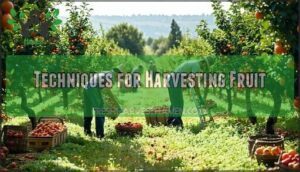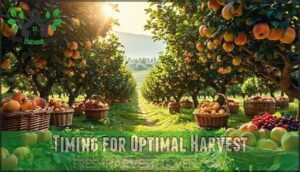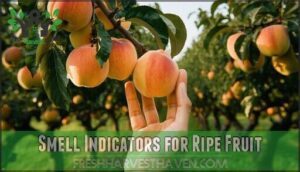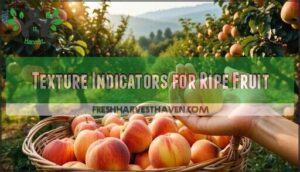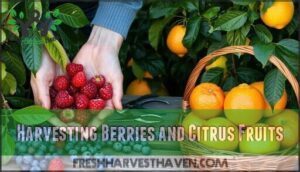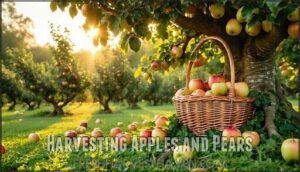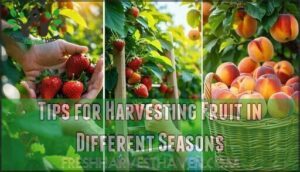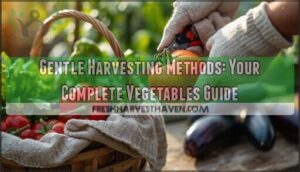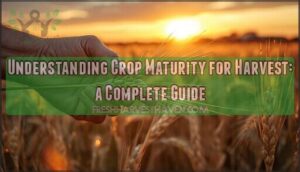This site is supported by our readers. We may earn a commission, at no cost to you, if you purchase through links.
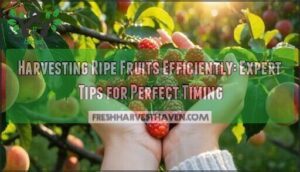
You’ll know it’s time when fruits display proper color changes, emit sweet aromas, and yield slightly to gentle pressure.
Pick during cooler morning hours when sugar content peaks and fruits handle transport better.
Use proper techniques like the "lift and twist" method for apples or supporting branches while picking berries.
Handle each fruit like it’s precious cargo – bruises lead to rapid spoilage and wasted effort.
Store different fruits according to their specific needs, separating ethylene producers from sensitive varieties.
Timing beats everything else in fruit harvesting success.
Master these fundamentals and you’ll discover advanced techniques that can double your harvest efficiency while maintaining premium quality.
Table Of Contents
- Key Takeaways
- Choosing The Right Fruit Tree
- Techniques for Harvesting Fruit
- Timing for Optimal Harvest
- Overcoming Challenges of Tall Trees
- Identifying Ripe Fruit
- Harvesting Techniques for Common Fruits
- Handling and Storing Harvested Fruit
- Common Mistakes in Harvesting Fruit
- Tips for Harvesting Fruit in Different Seasons
- Frequently Asked Questions (FAQs)
- How to properly harvest fruit?
- How do you speed up the ripening of fruit?
- What is the best stage of harvesting fruit?
- How to pick fruit faster?
- How to pick out ripe fruit?
- What is the best way to store ripe fruits?
- What is the best stage of harvesting fruits?
- How do you speed up the ripening process of fruits?
- How do you harvest ripe fruit?
- What fruit takes the longest to harvest?
- Conclusion
Key Takeaways
- Master the timing – You’ll harvest peak-quality fruit by picking during cool morning hours when sugar content is highest, checking for proper color changes, sweet aromas, and gentle firmness that yields slightly to pressure.
- Handle with care – You should cradle each fruit like precious cargo, using the "lift and twist" method to prevent bruising that leads to rapid spoilage and wasted effort.
- Separate ethylene producers – You’ll extend storage life by keeping ethylene-producing fruits like apples away from sensitive varieties and storing different fruits according to their specific temperature and humidity needs.
- Choose the right techniques – You can maximize efficiency by selecting appropriate harvesting methods for each fruit type, using specialty pickers for tall trees, and working systematically through rows to avoid missed areas.
Choosing The Right Fruit Tree
Selecting the right fruit tree sets the foundation for years of successful harvests and determines how easily you’ll gather ripe fruit from your garden.
Your choice affects everything from harvest timing to the tools you’ll need, making this decision pivotal for efficient fruit collection, as it influences the overall process of fruit collection.
Common Fruit Tree Varieties
Before you plant your first fruit tree, you’ll want to choose varieties that deliver reliable harvests.
These four apple cultivars and other fruit tree options offer different advantages for efficient harvesting:
- Apple Cultivars: Arkansas Black and Wolf River provide dependable yields with excellent storage qualities
- Peach Benefits: White Lady and Contender varieties offer easy cultivation and exceptional flavor profiles
- Cherry Varieties: Compact trees like Stella produce abundant ripe fruit in small garden spaces
- Pear Advantages: Hardy options like Rescue require minimal maintenance while delivering consistent fruit picking opportunities.
Consider also that dwarf fruit trees are ideal for smaller gardens.
Ideal Growing Conditions for Fruit Trees
Once you’ve selected varieties suited to your region, creating the right environment becomes your next priority. Your fruit tree’s success depends on matching Climate Adaptation needs with local conditions.
Most fruit trees require full Sunlight Exposure – aim for 6-8 hours daily. Without adequate light, you’ll get weak growth and poor fruit harvesting results. Water Needs vary by species, but consistent moisture without waterlogging works best.
Soil pH matters more than you’d think. Test your soil first – most fruit trees prefer slightly acidic to neutral conditions (6.0-7.0). Heavy clay or sandy soils need amendments for proper drainage and nutrition.
Pest Control planning starts now, not when problems appear. Choose disease-resistant varieties when possible. This proactive approach protects your investment and guarantees healthy ripe fruit production.
Here’s what different fruit trees need:
| Tree Type | Sunlight Hours | Soil pH Range | Water Frequency |
|---|---|---|---|
| Apples | 6-8 hours | 6.0-7.0 | Weekly deep watering |
| Peaches | 6-8 hours | 6.0-6.5 | Twice weekly |
| Citrus | 8+ hours | 6.0-7.5 | Regular moisture |
Soil and Sunlight Requirements
Your fruit trees thrive in well-draining soil with a pH between 6.0-7.0 and need six hours of direct sunlight daily.
The right conditions make all the difference between struggling saplings and productive trees.
- Test your soil pH annually using a digital meter for accurate nutrient uptake
- Choose loamy soil type that drains within 24 hours after heavy rain
- Apply soil amendments like compost to improve drainage importance and fertility
- Position trees where sunlight exposure isn’t blocked by buildings or larger plants to ensure they receive the necessary amount of direct sunlight, which is crucial for their growth and development into healthy trees.
Watering and Climate Needs
After establishing proper soil and sunlight conditions, you’ll need to master watering frequency and climate considerations to guarantee your fruit tree thrives. Climate impact affects every aspect of growth, from root development to harvest timing.
Young trees require consistent moisture, while established trees benefit from deep, infrequent watering that encourages strong root systems. You can create beneficial microclimates using windbreaks or strategic planting to protect against harsh conditions.
Here’s how watering needs change over time:
| Tree Stage | Watering Schedule |
|---|---|
| New plantings | Daily light watering |
| Young trees | Weekly deep soaking |
| Mature trees | Bi-weekly thorough watering |
| Drought-resistant varieties | Monthly deep irrigation |
Smart watering practices combined with understanding your local climate will set you up for successful harvests. Consider frost protection methods like tree wraps or sprinkler systems during vulnerable seasons. The right conditions mean healthier trees that produce better fruit when harvest time arrives.
Techniques for Harvesting Fruit
You’ll need the right techniques to harvest fruit without damaging your precious crop or injuring yourself in the process.
The methods you choose depend on your fruit type, tree height, and the delicate nature of what you’re picking, which involves considering complete concepts to ensure a successful harvest.
Using Catching Nets for Delicate Fruits
When delicate fruits start dropping, catching nets become your orchard’s safety net. These specialized harvesting tools protect soft fruits from bruising while streamlining collection.
Net Material varies by fruit type:
- Fine mesh nets – Perfect for berries and small stone fruits, preventing fruit bruising through gentle cushioning
- Heavy-duty fabric nets – Built for apples and pears, offering durability with effective Fruit Protection
- Expandable catching nets – Ideal for varying Orchard Layout configurations, maximizing coverage efficiency
Strategic placement under trees creates Labor Reduction by eliminating individual pickup trips. You can find various fruit catching solutions online.
While initial Cost Analysis shows investment requirements, these efficient harvesting techniques pay dividends through reduced waste and faster collection times.
Hand-Picking Methods for Ripe Fruit
Master the art of handpicking through proper gentle gripping techniques.
Cradle each ripe fruit in your palm, then twist gently upward—never yank.
Your picking bags should hang comfortably at waist level for seamless transfers.
| Technique | Application | Bruise Prevention |
|---|---|---|
| Two-hand cradle | Large apples/pears | Maximum support |
| Thumb-finger twist | Stone fruits | Clean stem break |
| Fruit rotation check | All varieties | Spot soft areas |
| Palm support | Delicate berries | Even pressure |
| Stem-first placement | Picking bags | Reduces contact |
Remember: resistant fruit isn’t ready.
Efficient harvesting means respecting nature’s timeline while maintaining fruit picking precision.
As fruit ripens, ethylene gas triggers changes that indicate readiness.
Safety Precautions for Harvesting
Safety practices keep you injury-free during harvesting.
Always inspect your ladder safety before climbing—check for cracks, loose bolts, or bent rungs. Position ladders on level ground with proper angle.
Wear protective gear including non-slip gloves and closed-toe shoes. Maintain tools regularly, checking handles and cutting edges.
Keep first aid supplies accessible for minor cuts. Monitor weather awareness—avoid wet or windy conditions that make handpicking dangerous.
Never overreach from ladders.
Timing for Optimal Harvest
You’ll maximize your harvest by learning to recognize ripeness indicators specific to each fruit variety.
Timing your harvest correctly prevents waste and guarantees the best flavor and storage life for your homegrown produce.
Signs of Ripeness for Various Fruits
Perfect ripeness transforms ordinary fruit into nature’s candy.
You can identify when fruit reaches peak quality using four key methods:
- Visual Cues – Color indicators show maturity as green fades to vibrant hues
- Aroma Significance – Sweet fragrance intensifies when sugar content peaks
- Texture Changes – Fruit firmness decreases slightly with gentle pressure
- Detachment Test – Ripe fruit separates easily from branches without force
These ripeness indicators work together to signal ideal harvest timing for maximum flavor.
A key indicator for peaches is to check for slight softness to touch.
Checking for Defects Before Harvesting
When inspecting fruit before harvest, you’ll spot problems that could affect your entire yield.
Check each piece for pest damage like holes or chew marks, and watch for disease signs such as dark spots or unusual growths.
Bruising prevention starts with gentle handling during inspection.
Look for sunburn spots – those pale or brown patches that indicate heat stress.
| Defect Type | Visual Signs | Action |
|---|---|---|
| Pest Damage | Holes, bite marks, larvae | Remove affected fruit |
| Disease Signs | Dark spots, mold, rot | Discard immediately |
| Sunburn Spots | Pale/brown patches | Use quickly or compost |
Check size uniformity and verify ripeness indicators match across your harvest for consistent fruit quality and ideal fruit maturity.
Overcoming Challenges of Tall Trees
Tall fruit trees can make harvesting feel like a puzzle you didn’t ask to solve.
You’ll need smart strategies to reach those high branches safely without turning your harvest into a gymnastics routine.
Pruning for Easier Access
Proper pruning timing during dormancy months transforms tall trees into manageable harvesting partners. Strategic branch structure modifications reduce ladder safety risks while improving growth habit control.
Start with sharp tool selection – clean cuts prevent disease and encourage healthy regrowth. Consider these key steps:
- Pruning timing: Target late winter dormancy periods
- Branch structure: Remove crossing or downward-growing limbs
- Growth habit: Open center pruning creates accessible canopies
- Tool selection: Sharp bypass pruners for branches under 1 inch
These branch training techniques make efficient harvesting possible without compromising fruit quality or tree health. Sterilizing tools helps to prevent disease spread.
Espalier or Cordon Techniques
Through strategic training systems, you’ll transform towering trees into manageable fruit harvesting powerhouses.
Espalier or Cordon Techniques create living art while solving height challenges.
These methods dramatically improve space efficiency by training branches horizontally along supports.
Pruning methods maintain structure while sunlight exposure reaches every branch uniformly.
The result? Superior fruit quality and effortless ripe fruit collection at arm’s reach.
| Technique | Benefits |
|---|---|
| Espalier | Multiple tiers, decorative patterns |
| Single Cordon | Minimal space, simple maintenance |
| Double Cordon | Higher yields, balanced growth |
| Fan Training | Enhanced airflow, disease prevention |
| Step-Over | Ground-level harvest, pathway borders |
Start with spur-bearing varieties on dwarfing rootstocks.
These efficient harvesting systems produce fruit within 2-3 years, delivering harvesting techniques that eliminate ladders forever.
Your fruit picking becomes a pleasant stroll rather than a precarious climb.
Using Specialty Pickers for Hard-to-Reach Fruits
Specialty pickers revolutionize high-branch harvesting without dangerous ladder climbing. These Picker Types feature Extension Poles that telescope up to 15 feet, reaching previously inaccessible fruit while minimizing Fruit Damage through gentle basket designs.
Here’s how telescoping pickers excel as Ladder Alternatives:
- Fruit picking poles extend your reach safely from ground level
- Longhandled pickers reduce physical strain during extended harvesting sessions
- Picking poles with cushioned baskets prevent bruising during collection
These tools are available on various online marketplaces. Safe Usage requires checking pole connections before reaching for high branches.
Identifying Ripe Fruit
You’ll need to recognize the perfect moment when your fruit reaches peak ripeness to guarantee maximum flavor and nutritional value.
Learning to read the subtle signs of color changes, fragrant aromas, and texture cues will help you harvest at exactly the right time for the best-tasting fruit, which is crucial for achieving peak ripeness.
Color Indicators for Ripe Fruit
When examining fruit, you’ll notice a color spectrum shift as ripeness develops.
Green strawberries transform to vibrant red, while bananas progress from green to golden yellow.
Pigment changes occur naturally through ripening stages—sunlight exposure enhances these transformations.
Each variety displays unique varietal colors when ready.
Look for deep, saturated hues rather than pale tones.
These color indicators serve as your primary guide for harvesting ripe fruits and ensuring ideal fruit harvesting timing.
Smell Indicators for Ripe Fruit
Your nose knows best in spotting ripe fruit. While color gives visual cues, aroma tells the real story of ripeness through complex Fruit Ester Profiles and Aroma Volatility.
Here’s what to sniff for:
- Sweet, floral fragrances signal perfect ripeness with peak Ripening Compounds
- Faint or no smell means you’re Detecting Under-ripe fruit that needs more time
- Heavy, alcoholic odors warn of Over-ripe Odors from fermentation starting
- Variety-specific scents like citrus oils or stone fruit perfume indicate ideal harvest timing
Trust your nose alongside other smell indicators. Ripe fruit releases volatile compounds that create those enticing aromas, making scent your most reliable partner in fruit harvesting decisions.
Texture Indicators for Ripe Fruit
While fragrance gives you clues about ripeness, your fingertips provide the final verdict. Fruit firmness tells you exactly when to harvest.
Press gently near the stem area using what experts call the yielding test. Ripe fruit should give slightly but bounce back. Too soft means overripe, while rock-hard indicates more waiting time needed.
Different fruits require different approaches to tactile maturity assessment:
Check for soft spots by running your palm across the surface. These indicate damage or overripeness that affects storage life. The skin feel should match the fruit type – berries need plump smoothness while apples require firm crispness.
Master these texture indicators and you’ll achieve efficient harvesting every time, picking fruit at peak quality.
Harvesting Techniques for Common Fruits
Different fruits need different harvesting approaches to keep them fresh and flavorful.
You’ll want to adjust your technique based on whether you’re picking delicate berries, sturdy citrus, or soft stone fruits, which can be considered a complete concept for harvesting various types of fruits.
Harvesting Berries and Citrus Fruits
Looking beyond visual cues, berries and citrus fruits demand different harvesting approaches for maximum market freshness. Your picking schedule matters – harvest berries during cool morning hours to prevent berry bruising and maintain ripe fruit quality.
Manual fruit harvesting requires specific techniques for each type:
- Twist and lift citrus gently – the "twist, jerk, and pull" method protects tight-skinned varieties
- Cup berries in your palm – this prevents crushing while checking ripeness
- Use pruning shears for citrus – clean cuts reduce damage and reach higher branches
- Watch for thorns on berry canes – protect yourself while maintaining gentle handling
Citrus acidity peaks when fruits reach full color, though some varieties like Valencia appear greenish when ripe. Unlike berries that continue ripening, citrus won’t improve after picking.
Storage solutions differ substantially – refrigerate berries immediately but store citrus at room temperature. This approach guarantees efficient harvesting while preserving quality from tree to table.
Harvesting Apples and Pears
Three proven techniques guarantee perfect apple and pear harvests every season. Fruit harvesting requires understanding variety differences and proper storage techniques to prevent apple bruising.
Efficient harvesting starts with timing:
- Test pear ripeness by gentle pressure near the stem
- Roll apples upward with a twisting motion to snap stems cleanly
- Harvest during cool mornings for extended ripe fruit quality
- Use padded containers to minimize damage during collection
- Maintain orchard sanitation by removing damaged fruit immediately
This systematic approach maximizes your harvest while preserving fruit quality.
Harvesting Peaches and Plums
Perfect timing separates amateur fruit pickers from seasoned harvesters. Peaches reach peak maturity stages when their peach fuzz feels soft and color shifts from green to deep orange-red. Plum firmness decreases as purple-blue skin develops rich fragrance.
Timing beats technique every time – ripe fruit tells you when it’s ready, not the calendar.
Test ripeness by pressing gently near the stem – ripe fruit yields slightly. Use the gentle twist method for fruit picking: rotate peaches upward while lifting to snap stems cleanly. For plums, push upward with your palm.
Long-handled tools reach higher branches safely without ladders. Bruise prevention starts with proper technique. Never pull or squeeze during fruit harvesting.
Place ripe fruit directly into padded containers. Handle stone fruits like precious gems – their delicate skin bruises easily, affecting storage duration and market value.
Handling and Storing Harvested Fruit
Once you’ve picked your fruit, proper handling and storage become essential for maintaining quality and extending shelf life.
The methods you choose—whether cooling, freezing, dehydrating, or canning—will determine how long your harvest stays fresh and nutritious.
Cooling and Refrigeration
Proper cooling slashes ripening speed and extends fruit life dramatically. Quick temperature reduction within hours of harvest can add days to shelf life while preserving texture and flavor.
- Cool fruit immediately using forced air systems or simple cooling chambers for ideal postharvest handling
- Maintain storage temperatures between 32-40°F depending on fruit type for effective temperature control
- Control storage humidity with ventilated containers while separating ethylene-producing fruits to prevent premature ripening
Smart refrigeration timing and cooling methods maximize your harvest’s value through proper temperature management. To maintain ideal humidity, consider using a storage hygrometer.
Freezing and Dehydration
Two powerful preservation methods extend your harvest’s lifespan while retaining quality and nutrients.
Freezing best practices involve washing ripe fruit, spreading pieces on trays until solid, then transferring to airtight containers.
Flash-freezing at -46°C preserves up to 97% of nutrients and prevents cell breakdown.
To achieve ideal results, consider investing in specialized freezing equipment designed for rapid cooling.
Dehydration methods require slicing fruits thinly and drying at 135°F until moisture content drops below 20%.
| Method | Storage Duration | Equipment Options |
|---|---|---|
| Flash Freezing | 12+ months | Blast freezers, home freezers |
| Freeze-Drying | 1+ years | Freeze-dry machines |
| Air Dehydration | 6-12 months | Dehydrators, ovens |
| Sun Drying | 4-8 months | Drying racks, screens |
| Vacuum Sealing | Extended life | Vacuum chambers |
Quality retention depends on proper storage conditions and airtight packaging after processing.
Canning and Preserving
Canning transforms your ripe fruit into shelf-stable treasures that last for years.
This time-tested preservation method requires attention to canning safety protocols but rewards you with delicious results.
Follow these essential steps for successful fruit preservation:
- Sterilize jars and lids using boiling water to prevent contamination
- Process high-acid fruits in a water bath canner at proper temperatures
- Create jam making masterpieces by combining fruit, sugar, and pectin correctly
- Test jar seals after cooling to guarantee proper vacuum formation
Master these fermentation methods and you’ll enjoy quality fruit processing results every harvest season.
Common Mistakes in Harvesting Fruit
Even experienced fruit growers make simple mistakes that can ruin their harvest.
These common errors can turn months of careful growing into disappointment, but they’re easy to avoid once you know what to watch for.
Picking Fruit Too Early or Too Late
Timing your harvest incorrectly often derails fruit quality from the start. Harvest timing mistakes create cascading problems that affect everything from Flavor Impact to Storage Longevity.
Early picking prevents proper Ripening Process completion, reducing Nutritional Value and taste development. Late harvesting increases Pest Susceptibility and shortens shelf life substantially.
| Issue | Early Harvest | Late Harvest |
|---|---|---|
| Flavor Impact | Sour, underdeveloped taste | Oversweet, mushy texture |
| Storage Longevity | Poor keeping quality | Rapid deterioration |
Master maturity indicators for each fruit type to achieve ideal fruit ripeness and maximize your harvesting ripe fruits success.
Not Handling Fruit Gently Enough
Although rushing might seem productive, careless fruit handling destroys your harvest’s value before it reaches the kitchen.
Bruising prevention starts with understanding that fruit damage occurs instantly when you yank, squeeze, or toss delicate produce. Training pickers in proper containers and gentle handling techniques saves more money than speeding through rows.
- Use gentle tools like padded picking bags and cushioned containers to prevent drop damage
- Master proper fruit handling techniques by cradling each piece and twisting gently rather than pulling
- Implement systematic handling fruit protocols that prioritize quality over quantity during collection
Smart harvesters know that gentle handling pays dividends. When you treat each apple, peach, or pear like a precious gem, you’ll maximize both storage life and market value while minimizing costly bruising that turns perfect fruit into compost.
Not Storing Fruit Properly
Poor storage can ruin perfectly harvested fruit faster than you’d think.
You’re undoing all your careful picking work when you toss everything together without planning.
Spoilage Prevention starts with separating ethylene gas producers like apples from sensitive fruits.
Temperature control matters hugely – most fruits need 32-40°F storage conditions.
Humidity levels should stay around 85-95% for ideal freshness.
Here’s your storage game plan:
| Fruit Type | Storage Method | Ideal Conditions |
|---|---|---|
| Berries | Refrigerate immediately | 32-35°F, high humidity |
| Stone fruits | Room temp, then freeze | Ripen first, then cooling |
| Citrus | Refrigerate loosely covered | 35-40°F, moderate humidity |
| Apples | Refrigerate in perforated bags | 32-35°F, high humidity |
| Bananas | Room temperature only | Never refrigerate |
Check your storing fruit regularly for decay spots.
Pest control means removing damaged fruit immediately before problems spread throughout your harvest.
Tips for Harvesting Fruit in Different Seasons
Each season brings unique fruit varieties that ripen at different times, requiring specific harvesting techniques to maximize quality and yield.
Understanding when and how to harvest spring strawberries, summer peaches, or autumn apples guarantees you’ll capture peak flavor and nutrition from your garden.
Harvesting Fruit in Spring
Spring fruit types require careful attention as frost impacts blossom timing substantially.
You’ll want to monitor cherries and strawberries daily for ripeness—they’ll show bright colors and soft textures.
Use gentle harvesting techniques like careful twisting to preserve delicate fruit.
Early morning picking maximizes quality while cooler temperatures prevent bruising.
Effective pest control protects your fruit yield throughout the harvesting season, and it’s crucial for maintaining the overall health of your fruit yield.
Harvesting Fruit in Summer
Summer brings peak harvesting season with intense heat and active summer fruit pests.
You’ll need to check trees daily since ripe fruit spoils quickly in high temperatures. Early morning picking prevents heat stress effects and preserves fruit quality before afternoon heat builds up.
Summer harvest labor requires smart timing and proper irrigation harvest impact planning:
- Beat the heat: Harvest at dawn when temperatures are coolest
- Stay hydrated: Keep yourself and fruit properly watered during picking
- Move quickly: Transfer harvested fruit to shade immediately to prevent sunburn fruit damage.
Regular picking during harvesting season stimulates continued fruit yield and harvest optimization throughout summer.
Harvesting Fruit in Autumn
Autumn harvesting requires sharp observation of autumn ripeness indicators. Weather impact affects fruit quality, so harvest apples when firm and properly colored.
For pears, pick early and let them ripen indoors. Pest concerns increase with fallen fruit, making leaf removal essential for orchard health.
Use proper harvesting techniques like gentle twisting motions for ripe fruit. Effective crop harvesting demands quick cooling post-harvest for ideal fruit quality and harvest optimization.
Proper winter prep starts with timely autumn collection.
Frequently Asked Questions (FAQs)
How to properly harvest fruit?
You’ll harvest fruit perfectly by checking ripeness through color, texture, and smell. Pick gently during cool morning hours using proper tools. Handle carefully to prevent bruising and preserve quality.
How do you speed up the ripening of fruit?
You’ll practically turn into a fruit-ripening wizard.
Place unripe fruit in a paper bag with a ripe banana or apple.
The ethylene gas they release speeds up ripening dramatically. Check daily and remove ripe pieces to prevent overripening.
What is the best stage of harvesting fruit?
You’ll achieve peak flavor and quality when you pick fruit at its "tree-ripe" stage. This means it’s fully developed but still firm enough to handle without bruising during harvest.
How to pick fruit faster?
Use systematic patterns when picking fruit.
Work in rows or sections to avoid missed areas.
Harvest during cooler morning hours for better efficiency.
Train your crew properly for consistent speed and quality results.
How to pick out ripe fruit?
The early bird catches the worm" applies perfectly here.
You’ll identify ripe fruit by checking color changes, gentle firmness, and sweet aroma.
Test texture with light pressure – it should yield slightly without being mushy or hard, and remember gentle firmness is key to not damaging the fruit, with a sweet aroma indicating readiness.
What is the best way to store ripe fruits?
Store ripe fruits in your refrigerator’s crisper drawer at proper humidity levels.
Cool temperatures slow ripening and extend freshness.
Keep ethylene-producing fruits like apples separate from sensitive ones to prevent premature spoilage.
What is the best stage of harvesting fruits?
Like the golden moment when Midas touched everything perfectly, you’ll harvest fruits when they’re fully ripe but still firm.
Check color, smell, and gentle pressure to determine peak ripeness for maximum flavor and storage life.
How do you speed up the ripening process of fruits?
Place fruits in paper bags with ripe bananas or apples.
These fruits release ethylene gas that accelerates ripening.
You can also keep unripe fruits at room temperature in a warm spot.
How do you harvest ripe fruit?
You’ll harvest ripe fruit by gently twisting and lifting each piece from the branch, checking for proper color, firmness, and sweet aroma.
Use clean hands or tools to avoid damage and bruising.
What fruit takes the longest to harvest?
Telegraph operators of yesteryear would marvel at today’s challenge: grapes demand the most time-intensive harvest.
You’ll spend weeks hand-picking clusters at perfect ripeness, making multiple passes through vineyards as different sections mature at varying rates, which can be a very time-intensive process.
Conclusion
Success in harvesting ripe fruits efficiently depends on mastering timing and technique together.
You’ve learned the essential signs of ripeness, proper handling methods, and storage requirements that prevent waste.
Remember to harvest during cool morning hours when sugar content peaks, apply gentle pressure tests, watch for color changes, and trust your nose for sweet aromas.
These proven methods will transform your harvest from guesswork into precise science, ensuring maximum yield and quality every season, with the ultimate goal of achieving the best possible results.
- https://bhooc.com/blogs/articles/manual-vs-mechanical-olive-harvesting-key-differences
- https://link.springer.com/article/10.1007/s10462-023-10674-2
- https://www.fdrsinc.org/wp-content/uploads/2024/01/54.3_3_Delbridge.pdf
- http://www.ers.usda.gov/amber-waves/2022/december/u-s-fruit-and-vegetable-industries-try-to-cope-with-rising-labor-costs
- https://agresearch.montana.edu/warc/research_current/berries/haskap/labor-estimates-for-small-scale-haskap-production.html

